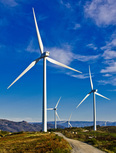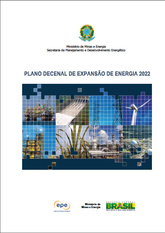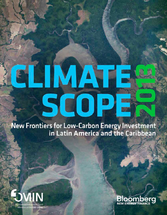

|
|
 SolEnergy Farms, together with Perfect Energy and Solar Horizon, will invest $150m in solar energy, with the aim of producing 60 MW in El Salvador, according to Power Engineering International. Initially, $35m will be invested in a 10 MW solar photovoltaic (PV) plant in the municipality of Tecoluca, in the central department of San Vicente. Sol Energy also indicated that it was considering investing an additional $40m in a second phase to produce and sell 40 MW to AES, the private utility.
 Wind farms won all the contracts in Brazil's November 18, 2013 A-3 auction for new power capacity. Developers of thirty-nine contracted projects will install 868 MW of capacity and sell energy at an average price of 124.43 reais ($54.87) a megawatt-hour, according to EPE. Wind, solar, small hydro, and biomass competed in the auction. Brazil is on track to auction more than 3,000 megawatts of wind in 2013, the most ever, Elbia Melo, president of the wind energy trade group Associacao Brasileira de Energia Eolica (ABEEólica), told Bloomberg. That will benefit turbine suppliers including France’s Alstom SA (ALO) and Spain’s Acciona SA that are investing in factories to meet a local-content requirement. Brazil: Industry Consortium Proposes Three Solar Only Auctions of 500MW each in 2014, 2015, and 201611/12/2013
 Three Brazilian industry associations, The Brazilian Association of Independent Power Producers (APINE), the Industry Association of Cogeneration (COGEN), and the Brazilian Electrical and Electronics Industry Association (ABINEE), are preparing to send the government a proposal for solar only auctions. The three 500MW auctions will be held in 2014, 2015, and 2016, according to COGEN. Solar energy would be supplied for 25 years starting in 2016. As reported in PV-Tech, executive vice president of COGEN, Leonardo Calabró, said a reasonable price for the auction to offer is BRL190 (US$83) to BRL200 (US$87), per MWh, as solar is not yet competitive with wind and other energy sources in Brazil. He said it was therefore unfair for solar to compete in this year's A-3 and A-5 energy auctions; the first national auctions open to include solar projects. The proposed plan also includes two auctions for other renewable energy projects, in 2015 and 2016, which could expand to include biomass, wind and hydro.  Pedro Joaquín Coldwell, the head of Mexico's energy ministry Sener, this week in Cancún laid out five reforms to promote renewable power in Mexico. 1) Create an independent system operator that manages expansion of the transmission network and all interconnection permits. 2) Facilitate the sale of renewable power through creation of a regulated wholesale generation market. 3) Develop mechanisms for distributed generation projects, which is still unknown territory in Mexico. 4) Create demand for renewable energy through stronger implementation of renewable goals and stimulate cheap renewable energy financing. 5) Establish regulation for public consultations on renewable projects to ensure inclusiveness in communities and mitigate negative externalities of projects. For more see BN Americas (subscription required).  In an extensive article, the Washington Post reports: "Though hydropower, which generates the vast majority of electricity, will remain vital, the government’s energy planners say that by 2025, dam building may be tapped out as a viable alternative. Projects like Belo Monte — a gargantuan dam whose construction has generated relentless protests by environmentalists and Indians — appear to be a thing of the past. Instead, the Energy Ministry wants wind and biomass, which here means sugar-cane waste, to provide 30 percent of new electricity generation."  Enel Green Power, controlled by Italy's Enel, Europe's No. 2 utility, is shifting more of its investments away from Italy and Spain to emerging economies, according to Reuters. In Latin America, Enel's Spanish unit Endesa is seeking to develop 700 megawatts of renewable capacity in Brazil and 500 megawatts in Chile by 2017.  The Brazilian government has released the latest Ten Year Energy Expansion Plan (PDE 2022) for public consultation. Comments are due by November 10 (send to pde2022@mme.gov.br).  The countries of Latin America and the Caribbean (LAC) are attracting more clean energy investment as governments strengthen policy support and local supply chains expand, according to Climatescope 2013, a new report from the Multilateral Investment Fund (MIF) and Bloomberg New Energy Finance (BNEF). The LAC region captured 6% of the total $268.7 billion invested worldwide in clean energy in 2012, up from 5.7% in 2011. (For purposes of the Climatescope analysis, clean energy is defined as wind, solar, biomass, small hydro, geothermal and other renewable power generation, and biofuels.) “The rapidly falling costs of clean technologies such as solar and wind power combined with an improved investment climate means that clean energy generation in the region is now truly affordable,” said Nancy Lee, General Manager of the MIF. The Global Cleantech 100 List is a list of the top 100 private companies in clean technology. Collated by combining proprietary Cleantech Group research data, with over 9,000 nominations and specific input from an expert panel, these companies represent the most innovative and promising ideas in cleantech—the companies that are most likely to make the most significant market impact over the next 5-10 years.
A total of 18 countries are represented on this year’s list year (a record), with the first entrant from Latin America. 61% of the companies on the list came from the North America region (with 56 companies from the United States). 32 of the companies are from the Europe & Israel region, six from Asia Pacific and, for the first time, a company from South America. Pure Biofuels de Perú specialises in liquid fuels storage, distribution, marketing, and biodiesel production in Peru. The concept of cleantech embraces a diverse range of products, services, and processes across industry verticals that are inherently designed to (a) Provide superior performance at lower costs, (b) Greatly reduce or eliminate negative ecological impact, and (c) Improve the productive and responsible use of natural resources.  Chilean Energy Minister Jorge Bunster and Indian Minister of New and Renewable Energy Farooq Abdullah met in Santiago, Chile in September to explore greater collaboration between the two countries in renewable energy development. Abdullah offered India’s support and expertise to Chile in setting up renewable projects as well as in capacity building and project preparation through the services of Indian experts and institutions like Centre for Wind Energy, Solar Energy Centre, and Alternate Hydro Energy Centre, according to a statement by the Indian government. The minister also offered training slots in India to Chilean scientists, engineers and technicians through the Indian Technical and Economic Cooperation (ITEC) Programm, and expressed his country’s desire for a serious and meaningful cooperation with Chile and the entire Latin American region. Chile is almost entirely dependent on imports for meeting its energy requirements and is looking to diversify by introducing a large component of renewable energy in its energy mix. Bunster noted the Chilean government’s interest in setting up a 50 megawatt solar thermal generating capacity in the north of the country, according to the statement. |
Categories
All
Archives
January 2025
Blogroll
|
|
© 2013 - 2025 InterAmerican Clean Energy Institute, a project of Earth Ways Foundation Inc, a 501(c)3 nonprofit organization.
|
Web Hosting by iPage
|

 RSS Feed
RSS Feed